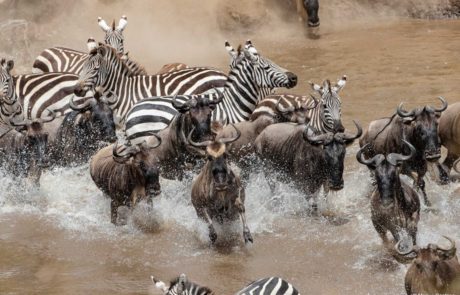Tanzania Wildebeest Migration Safari
During the Tanzania wildbeest migration Safaris, you will not only witness the thrilling river crossings, where crocodiles lie in wait, but also the incredible predatory interactions as lions, cheetahs, and hyenas stalk their prey amidst the chaos of this mass movement.
Design your trip
Design your trip
Tanzania Wildebeest Migration Safari: A Natural Phenomenon
Embark on an unforgettable adventure through Tanzania’s vast wilderness to witness the incredible phenomenon known as the Great Wildebeest Migration. Explore the diverse landscapes of the Serengeti National Park, Ngorongoro Conservation Area, and beyond, as millions of wildebeest and zebras traverse through East Africa in search of greener pastures. This SEO content will provide insights into the Great Migration, its movement throughout the year, and the best time to experience this natural spectacle.
What is the Great Migration?
The Great Migration refers to the annual movement of over two million wildebeest, accompanied by hundreds of thousands of zebras and other herbivores, across the East African plains. Spanning around 1,800 miles, this migration cycle takes these animals through varying terrains and ecosystems in search of fresh grazing grounds and water sources.
How the Great Migration moves throughout the year
Southern Serengeti & Ngorongoro Conservation Area (December-March): During the calving season, witness the birth of thousands of wildebeest calves in the Southern Serengeti. With an abundance of food available, the herds remain in this region, offering incredible game viewing opportunities. Explore the Ngorongoro Crater and the surrounding plains, as predators gather to take advantage of the vulnerable young calves.
Central Serengeti (April-June): As the dry season sets in, the migrating herds move further northward, reaching the central Serengeti. This region offers exceptional predator sightings and thrilling encounters as the animals congregate near reliable water sources. Witness the heart-pounding river crossings across the Grumeti River, filled with crocodiles and other potential dangers.
Northern Serengeti (July-August): This period marks one of the highlights of the Great Migration, as the herds make their way towards the Mara River in search of fresh pastures. The dramatic river crossings are a sight to behold, with wildebeest leaping into the water, braving the currents, and evading the jaws of waiting crocodiles. This stage often sees the herds venturing into Masai Mara in Kenya.
Northern Serengeti & Western Corridor (September-October): With the dry season persisting, the herds start returning south from the Mara River, offering another thrilling opportunity to witness river crossings. The Western Corridor in the Serengeti provides thrilling game drives as the animals make their way back towards the plains of the Southern Serengeti.
The best time for Tanzania wildbeest Migration Safaris
For those interested in experiencing the calving season, the best time to visit the Serengeti is between December and March. During this time, the wildebeest herds gather in the southern Serengeti and Ndutu areas to give birth to their young. Witnessing the birth of thousands of wildebeest calves is a truly remarkable experience. The newborns take their first steps within minutes of being born and it is fascinating to see them trying to keep up with the rest of the herd. This period also attracts predators like lions, cheetahs, and hyenas, making it an exhilarating time for wildlife enthusiasts.
On the other hand, if your aim is to witness the famous river crossings, the best time to visit is between July and August. During this period, the wildebeest herds reach the Grumeti River and the Mara River, both of which present significant obstacles they must cross. The danger and drama of these moments are unparalleled, as crocodiles lie in wait for their opportunity to strike and lions position themselves to prey on the weaker animals. It is a spectacle of nature that leaves visitors in awe of the determination and resilience of these creatures.




